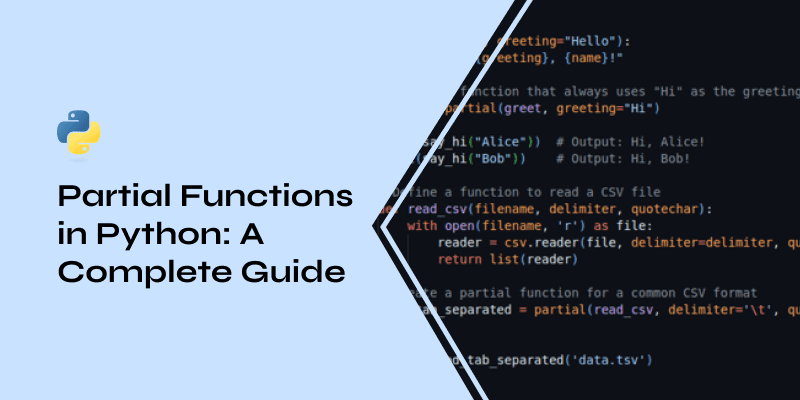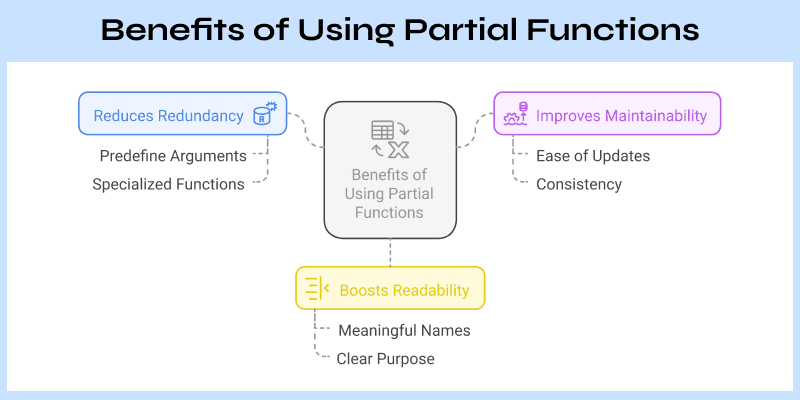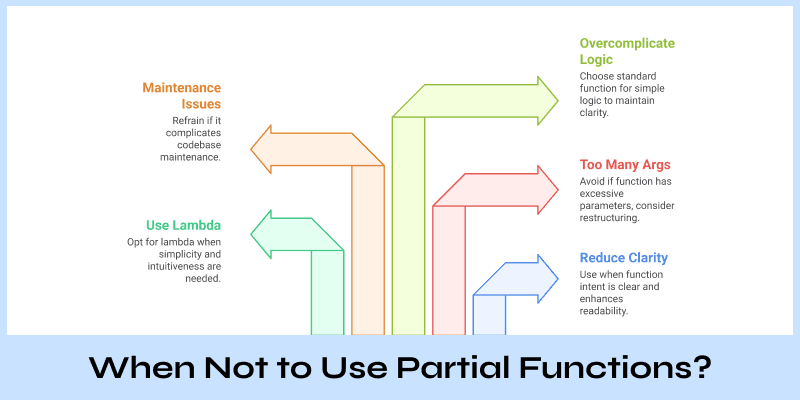Partial Functions in Python: A Complete Guide

Python is known for its simplicity and readability, and one of its lesser-known but powerful features is partial functions. In this guide, we’ll explore what partial functions are, how they work, and why you might want to use them in your projects.
What Are Partial Functions?
A partial function in Python is a tool that allows you to “freeze” some portion of a function’s arguments and keywords. Essentially, you create a new version of an existing function with one or more arguments pre-set. This can simplify your code, especially when you need to call a function multiple times with similar parameters.
For example, imagine you have a function that multiplies two numbers. By using a partial function, you can preset one of the numbers so that you only need to provide the other when calling the function.
How to Create a Partial Function
Python’s built-in functools module provides a convenient way to create partial functions using functools.partial. Here’s a simple example:
from functools import partial
def multiply(x, y):
return x * y
# Create a new function that always multiplies by 2
double = partial(multiply, 2)
# Now, calling double(5) is the same as multiply(2, 5)
result = double(5)
print(result) # Output: 10
Handling Keyword Arguments with Partial Functions
Partial functions can also pre-set keyword arguments:
from functools import partial
def greet(name, greeting="Hello"):
return f"{greeting}, {name}!"
# Create a function that always uses "Hi" as the greeting
say_hi = partial(greet, greeting="Hi")
print(say_hi("Alice")) # Output: Hi, Alice!
print(say_hi("Bob")) # Output: Hi, Bob!
Partial Functions in Data Processing
Partial functions are helpful in data processing tasks where certain parameters remain constant.
Example: Reading a CSV file with specific delimiter settings.
import csv
from functools import partial
# Define a function to read a CSV file
def read_csv(filename, delimiter, quotechar):
with open(filename, 'r') as file:
reader = csv.reader(file, delimiter=delimiter, quotechar=quotechar)
return list(reader)
# Create a partial function for a common CSV format
read_tab_separated = partial(read_csv, delimiter='\t', quotechar='"')
# Usage
rows = read_tab_separated('data.tsv')
print(rows)
Combining Partial Functions and Lambdas
Partial functions and lambdas can work together for more flexibility.
from functools import partial
# A function that performs a mathematical operation
def operation(x, y, func):
return func(x, y)
# Using partial to fix one argument and using lambda for the other
add = partial(operation, func=lambda a, b: a + b)
multiply = partial(operation, func=lambda a, b: a * b)
print(add(3, 5)) # Output: 8
print(multiply(3, 5)) # Output: 15
What is the Difference Between a Full Function and a Partial Function?
What is the Difference Between Partial and Closure in functools?
While both partial functions and closures allow argument pre-setting, they differ in how they achieve it:
Example of Closure:
def multiplier(factor):
def multiply(n):
return n * factor
return multiply
double = multiplier(2)
print(double(5)) # Output: 10Example of Partial Function:
from functools import partial
def multiply(x, y):
return x * y
double = partial(multiply, 2)
print(double(5)) # Output: 10
When and Why to Use Partial Functions
Simplifying Repetitive Code
Imagine you have a function that logs messages with various levels (info, warning, error). By creating partial functions for each log level, you can reduce redundancy and make your code more concise.
Enhancing Code Readability
By pre-setting some arguments, your functions can become more focused. Instead of passing the same parameters over and over, you can define specialized versions of your functions, making the code easier to understand.
Use in Data Science and Machine Learning
Partial functions can be very handy in data science projects. For instance, when applying a specific transformation to a dataset repeatedly, you can create a partial function that sets common parameters, thereby reducing code clutter.
Benefits of Using Partial Functions

1. Reduces Redundancy
Partial functions help eliminate repetitive code by allowing you to predefine certain arguments in a function. Instead of passing the same values repeatedly, you can create a specialized version of the function that already includes those arguments. This is especially useful when dealing with commonly used parameters, saving both time and effort.
2. Improves Maintainability
When a function relies on a parameter that may change over time—such as a tax rate, a discount percentage, or a default configuration—partial functions make updates easier. Instead of modifying multiple occurrences throughout your code, you only need to update the value in one place. This reduces the chances of errors and ensures consistency across your program.
3. Boosts Readability
Using partial functions allows you to create more meaningful and self-explanatory function names. Instead of repeatedly calling a general function with different parameters, you can define specific variations that clearly convey their purpose. This makes your code easier to read, understand, and maintain, especially for other developers working on the same project.
When Not to Use Partial Functions

While partial functions are a powerful tool, they are not always the best solution. If used inappropriately, they can make code harder to read, understand, and maintain. Here are some scenarios where partial functions may not be the best choice:
1. When They Reduce Clarity
Partial functions are meant to simplify code, but excessive use or improper naming can make it harder to understand what a function does. If someone reading the code cannot easily determine what a partial function represents without looking up its original definition, it may be a sign that a more explicit function or refactoring is needed.
2. When a Lambda Function Is More Suitable
In some cases, using a simple lambda function can be more intuitive than defining a partial function. If the transformation is straightforward and only needed in one place, a lambda function can make the intent clearer without adding an extra layer of abstraction.
3. When the Function Has Too Many Arguments
Partial functions work best when pre-filling one or two commonly used arguments. If a function has too many parameters and multiple partial functions are created for different argument combinations, it can quickly become confusing. This might indicate that the function itself needs restructuring or breaking into smaller, more specific functions.
4. When the Codebase Becomes Harder to Maintain
If partial functions are used extensively across a project, it may lead to difficulties in tracking where specific values are being set. Unlike explicitly passing arguments, which makes dependencies clear, partial functions can hide crucial information, making debugging and updates more complex.
5. When It Overcomplicates Simple Logic
Not every function needs a partial version. Sometimes, defining a normal function with well-named parameters is a cleaner and more understandable approach. Introducing partial functions for minor optimizations in places where they don’t add significant benefits can make the code unnecessarily complex.
Conclusion
Partial functions in Python are a powerful tool to make your code more modular, readable, and easier to maintain. They allow you to create specialized functions by pre-setting common parameters, saving time and reducing repetitive code. Whether you’re handling data, building web applications, or working on any other Python project, understanding partial functions can significantly streamline your development process.
